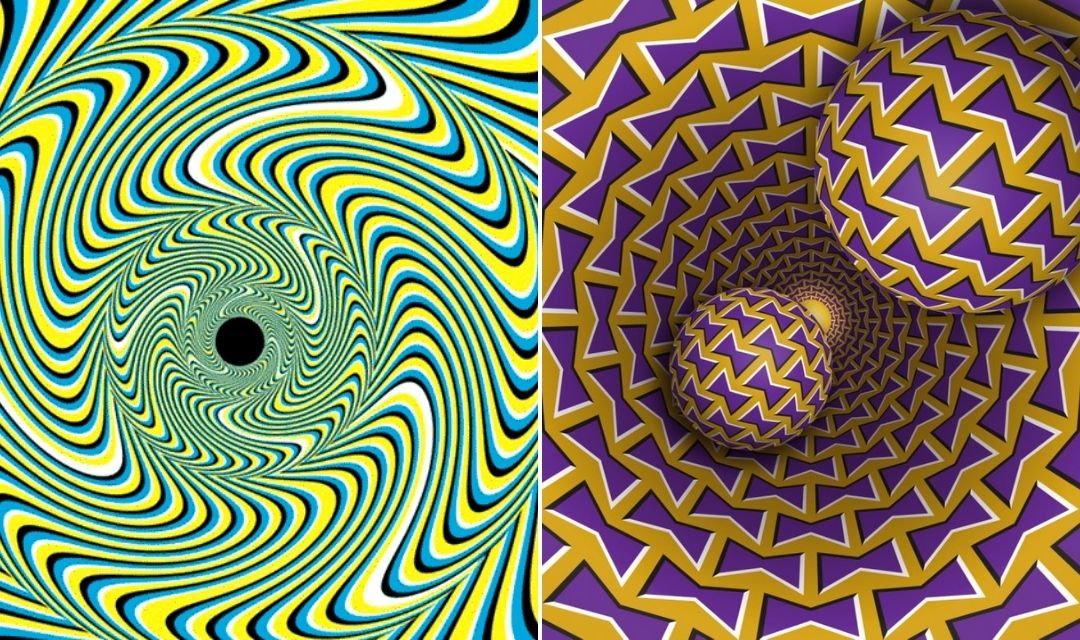What are optical illusions and why do we like them so much?
April 26, 2022
Our mind and vision come together in this game
Not everything we see is what it seems
Surely, you have seen in many places, mainly on the internet, images that seem to be in motion. Flat images that seem to be in three dimensions or silhouettes that, when you stop looking at them, remain engraved in your vision. These images that try to deceive us are called optical illusions. We are going to know what optical illusions are and why we like them so much.
In most cases, our eyes give us the correct information, but the brain cannot interpret it. In others, the image is impossible for us, even if the brain interprets the data of what we are looking at. Optical illusions trick our vision or our brain?
What are optical illusions?
Optical illusions are distortions of reality and perception. These images deceive the visual system, from our eyes to the brain.
These games can be created by visual effects and also occur naturally. They are the result of the analysis of the information received by the visual system, which can even perceive objects that are not present.
How do we see?
Our eyes are the means of looking at what is around us, but in reality, we see with the brain.
When we have an object in front of us, its image is formed on the retina of each eye. However, we see only one image. We do not see double because the brain processes the information with the rest of the data that comes through any sensory route, not just the visual.
Why are they formed?
When several shapes and patterns are presented in a single image, our brain comes into conflict, because it has an optical illusion before its vision. This is when our senses work together to filter information from the outside so it can be processed and even modified by the brain.
The process by which our brain combines information about the perception of color, shapes, movements, textures, places, and achieves a cohesive interpretation with all of them, is complex and the only thing that is known with certainty is that it does not have the sufficient capacity to handle all the information we receive through what we see. That is why the mind is forced to intervene, choosing the interpretation that seems most logical.
Optical illusions can be divided into two groups: physiological optical illusions and cognitive optical illusions.
Physiological optical illusions
These illusions are associated with the effects of excessive stimulation on the eyes, such as brightness, color or movement.
An example is post-images. The images that remain in our eyesight after observing a very luminous object or the adaptive stimulus in the face of highly contrasted changing patterns.
Stimuli have individual pathways for the first phase of the visual process and repeatedly stimulating some of those pathways creates confusion in the visual mechanism.
Cognitive optical illusions
These illusions work through various experiments that attack a certain vulnerability of vision and our knowledge of the world intervenes in them. A clear example of cognitive illusions is images that appear different from what they are.
They are classified as follows:
Illusions of ambiguity: these are divs that present two non-simultaneous perception alternatives.
Distortion illusions: they are the most common and in them, errors of perception of size, length and any geometric property are observed.
The paradoxical illusions: they present impossible objects.
Fictitious illusions (also known as hallucinations): generally, hallucinations are usually the result of states of mental alteration. In these illusions, we perceive images that do not exist.
All optical illusions can vary from one person to another depending on factors such as visual acuity, visual field, color blindness, astigmatism, among others.
When we understand these phenomena, we are closer to understanding the limitations we have in our visual sense and the possibility of distortion of images or shapes according to color, dimension, and perspective.
Optical illusions in art
Many artists have given their works a magical touch using optical illusions, creating depth, contrast, and ambiguity, pushing those of us who admire their works to our sensory limits.
When it comes to art, it is not an error of our visual perception. What we are observing is the will of the artist deforming the objective perception or creating elements that are impossible according to physical laws, but that satisfy their wishes.
Mannerist Giuseppe Arcimboldo
The Milanese artist of the 16th century, who was an inspiration for the surrealist painters of the 20th century, painted Reversible Head with Basket of Fruit. One of his main works that deceive the eye with the exercise of building and destroying one image in favor of the other.
Charles Allan Gilbert
He offered at the end of the 19th century the black and white drawing “Everything is vanity' in which our gaze tries to focus on the drawing of the woman in front of the mirror or the skull that encompasses everything.
Salvador Dalí
Faced with the intense global anxiety about the possibility of a nuclear armageddon, the Spanish surrealist Salvador Dalí created “Galatea de las esferas'. In this work, you can see the propulsion towards those who observe it, of countless atoms suspended in the middle of a nuclear explosion. As you move away, the spheres come together to show the timid face of a woman. Can you see them?
Daniel Siering and Mario Schuster
Graphic designer Daniel Siering and artistic director Mario Schuster transformed a lone tree in Potsdam, Germany, into a balanced trunk using paint and aluminum foil. At first glance, the tree appears to be suspended in midair.
M.C. Escher.
Dutch designer M.C. Escher is one of the most famous artists who included optical illusions in his different works. His paintings that were “impossible' have become legendary. Stairs that start somewhere and never end, the river that flows upward and seems to be flowing downward at the same time and hands that draw each other.
His obsession with mathematics and repeating patterns made prominent contemporary philosophers and physicists admire him.
Howard Lee
This British artist and his work fascinate a large number of people who follow him on his YouTube channel and regularly see what he is capable of creating with optical illusions.
Leon Keer
His unusual talent for perspectives is something that makes this Dutch artist special. He paints the streets with his 3D drawings, which were previously created digitally.
These images work if they are observed from a specific point, otherwise, they will be distorted.
In conclusion, our brain has the ability only to concentrate on an object, and when a single image is presented in two or more different ways, the brain goes into disorder generating confusion that leads to seeing something different from what it is, producing optical illusions.
Now that you know in more detail how our mind and senses work together, surely you will try to pay more attention to send the correct information. I recommend you get carried away with the moment and enjoy what your brain and vision are trying to decode.

Me encanta vivir nuevas experiencias y aprender de los constantes cambios de la vida. Amante de las ...

Posts Relacionados
Grupo Xcaret
Hotels






